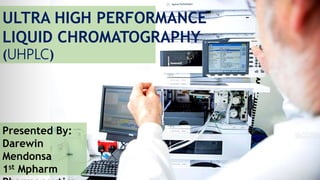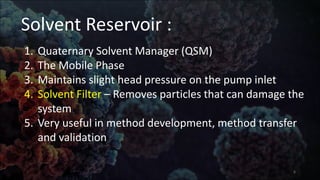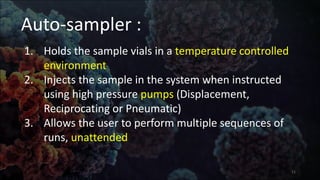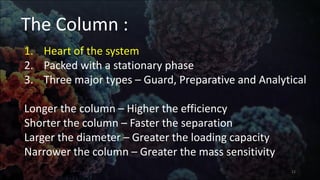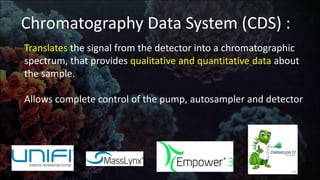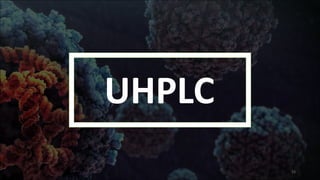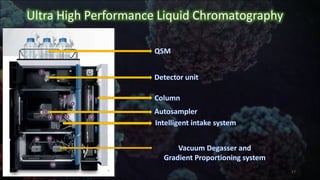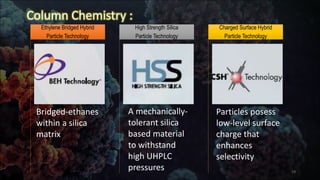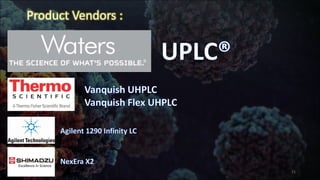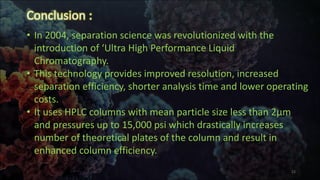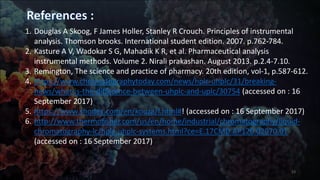UHPLC/UPLC: Ultra High Performance Liquid Chromatography
- 1. Presented By: Darewin Mendonsa 1st Mpharm ULTRA HIGH PERFORMANCE LIQUID CHROMATOGRAPHY (UHPLC)
- 2. Analytical Science Deals with methods for determining chemical composition of samples of matter using various techniques Separation Science Most commonly carried out by chromatography and electrophoresis, particularly with samples that are multicomponent and complex 2
- 3. Electromagnetic Radiation Electric Current Mass Rate of Reaction Thermal Characteristics Radioactivity ? Gravimetry (Quartz crystal balance) ? Mass Spectrometry ? Turbidimetry ? Nephelometry ? Raman Spectroscopy ? Refractometry ? Interferometry ? Nuclear Magnetic Resonance ? Potentiometry ? Chronopotentiometry ? Coulometry ? Amperometry ? Polarography ? Conductometry ? Emission spectroscopy ? Florescence ? Phosphorescence ? Kinetic Methods ? Thermal Gravimetry and Titrimetry ? Diffrential Scanning Calorimetry ? Diffrential Thermal Analysis ? Thermal Conductance Methods ? Activation and Isotope Dilution Methods 3
- 4. CHROMATOGRAPHY ADSORBTION Solid - Liquid Column Chromatography Thin Layer Chromatography HPTLC Solid ©C Gas (GSC) PARTITION Liquid ©C Gas (GLC) Liquid ©C Liquid Thin Layer Chromatography Paper Chromatography Column Chromatography HPLC ION EXCHANGE Ion Exchange Chromatography MOLECULAR SIEVE Gel Chromatography 4
- 5. High Performance Liquid Chromatography (HPLC) Involves separation of compounds on a stationary phase column Solvent Reservoir Vacuum Degasser Gradient Proportionating Valves Manifold AutosamplerColumnDetectorCDS 5
- 6. Solvent Reservoir : 1. Quaternary Solvent Manager (QSM) 2. The Mobile Phase 3. Maintains slight head pressure on the pump inlet 4. Solvent Filter ©C Removes particles that can damage the system 5. Very useful in method development, method transfer and validation 6
- 7. 13% 10% 6% 71% 14% 10% 5% 71% 13% 10% 6% 71% 12% 10% 7% 71% pH 4.33pH 4.0pH 3.3 pH 5.25 Water 125 mM Formic Acid Acetonitrile 125 mM Ammonium Hydroxide Mobile phase of varying pH prepared by adjusting the percentage of solvents mixed 7
- 8. Vacuum Degasser : Eliminates any dissolved gases that can interfere with the flow or compromise the automated proportioning 8
- 9. Gradient Proportioning Valves : They open in sequence, where the proportion of time that each valve is open corresponds to the percentage of the solvent that is specified in the gradient table. 9
- 10. Manifold : 1. This is where the four solvents first meet 2. Opens into the intelligent intake valve that leads to the pump 10
- 11. Auto-sampler : 1. Holds the sample vials in a temperature controlled environment 2. Injects the sample in the system when instructed using high pressure pumps (Displacement, Reciprocating or Pneumatic) 3. Allows the user to perform multiple sequences of runs, unattended 11
- 12. The Column : 1. Heart of the system 2. Packed with a stationary phase 3. Three major types ©C Guard, Preparative and Analytical Longer the column ©C Higher the efficiency Shorter the column ©C Faster the separation Larger the diameter ©C Greater the loading capacity Narrower the column ©C Greater the mass sensitivity 12
- 13. Detectors : Receives the result of the sample separation from the column and monitors a physical property which changes as the sample elutes Photo Diode Array Refractive Index Ultraviolet Visible Florescence Evaporative Light Scattering Mass Spectrometer Optical Rotation Electrochemical Conductivity PDA RI UV FL VIS ELS MS EC OR CD 13
- 14. Chromatography Data System (CDS) : Translates the signal from the detector into a chromatographic spectrum, that provides qualitative and quantitative data about the sample. Allows complete control of the pump, autosampler and detector 14
- 15. UHPLC 15
- 16. Ultra High Performance Liquid Chromatography Column Ī«mean- particle-sizeĪ» less than 2 micron Almost double the conventional operating pressures (~15,000 psi) Optimal Linear Flow Rates achieved Increased Efficiency Higher Resolution Shorter Analysis Time Lower Operating Costs 16
- 17. Ultra High Performance Liquid Chromatography 17
- 18. Theoretical Principle : Plate Theory: ? = ? ? N = Number of theoretical plates L = Length of column packing H = Plate height Higher the number of theoretical plates, better the column efficiency Column efficiency increased Number of theoretical plates increased Plate height greatly decreased Particle size lower than 2”╠m 18
- 19. Column Chemistry : Ethylene Bridged Hybrid Particle Technology High Strength Silica Particle Technology Charged Surface Hybrid Particle Technology Bridged-ethanes within a silica matrix A mechanically- tolerant silica based material to withstand high UHPLC pressures Particles posess low-level surface charge that enhances selectivity 19
- 20. 20
- 22. Conclusion : ? In 2004, separation science was revolutionized with the introduction of Ī«Ultra High Performance Liquid Chromatography. ? This technology provides improved resolution, increased separation efficiency, shorter analysis time and lower operating costs. ? It uses HPLC columns with mean particle size less than 2”╠m and pressures up to 15,000 psi which drastically increases number of theoretical plates of the column and result in enhanced column efficiency. 22
- 23. 1. Douglas A Skoog, F James Holler, Stanley R Crouch. Principles of instrumental analysis. Thomson brooks. International student edition. 2007. p.762-784. 2. Kasture A V, Wadokar S G, Mahadik K R, et al. Pharmaceutical analysis instrumental methods. Volume 2. Nirali prakashan. August 2013. p.2.4-7.10. 3. Remington, The science and practice of pharmacy. 20th edition, vol-1, p.587-612. 4. https://www.chromatographytoday.com/news/hplc-uhplc/31/breaking- news/what-is-the-difference-between-uhplc-and-uplc/30754 (accessed on : 16 September 2017) 5. https://www.shodex.com/en/kouza/f.html#! (accessed on : 16 September 2017) 6. http://www.thermofisher.com/us/en/home/industrial/chromatography/liquid- chromatography-lc/hplc-uhplc-systems.html?ce=E.17CMD.AP120.02970.01 (accessed on : 16 September 2017) 23
- 24. 24

